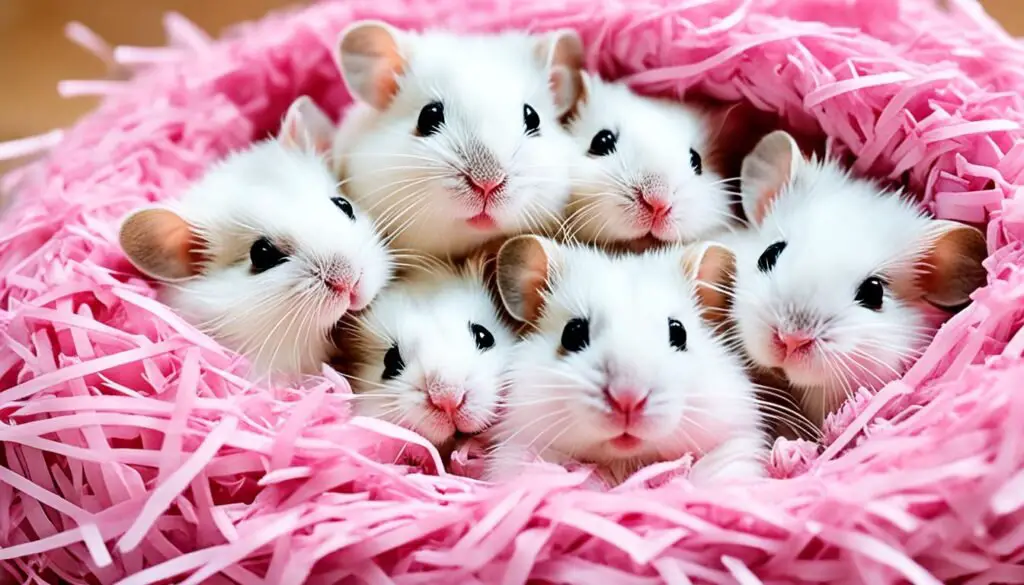Did you know that female hamsters can become pregnant as early as 4 weeks old? That’s right, these little rodents can start reproducing at a remarkably young age, which means it’s essential for hamster owners to be aware of the signs of pregnancy in their furry friends. Whether you’re a new hamster owner or an experienced enthusiast, knowing when your hamster is pregnant is crucial for their health and the well-being of their offspring.
In order to determine if your hamster is pregnant, there are some signs to look out for. These include a noticeable bulge in the abdomen, increased nesting behavior, and hoarding more food than usual. Syrian hamsters have a gestation period of 16 days, while Roborovski hamsters have a more variable gestation period.
Hamster Birth Process and Care for Newborns
During the hamster birth process, it’s important to provide a quiet and undisturbed environment for the mother and pups. Hamsters typically give birth late at night, but there are instances when they can deliver during the day. To ensure the safety and well-being of the newborns, it’s crucial not to intervene or handle them at this time.
Prior to giving birth, the mother hamster will groom herself and pace around. Once the birth begins, the pups will be born blind, deaf, hairless, and pink. They are completely dependent on their mother for nourishment and warmth. It’s a remarkable sight to witness as they rely on their instincts to find their way to their mother’s teats.

After about five days, the newborn hamsters will start developing pigment, gaining color in their fur. At around ten days old, they will begin to venture outside the nest, exploring their surroundings. However, it’s important to handle the pups gently and limit unnecessary contact during their fragile early days.
As they continue to grow, it’s vital to separate the sexes of the hamsters at the appropriate age. This step helps prevent unwanted breeding and potential fights as they reach maturity. By ensuring their physical and emotional well-being, you can contribute to a harmonious and safe environment for your hamster family.
Weaning and Separation of Hamster Pups
Once Syrian hamster pups reach around 3 weeks old, it’s time to begin the weaning process. At this stage, the mother may start pawing at the pups to encourage their independence. It’s important to allow the mother to continue nursing if she chooses to do so.
However, by the time the pups are 4 weeks old, it’s crucial to separate them by gender to prevent unwanted breeding and fighting. This is essential for maintaining a harmonious hamster community.
When it comes to Roborovski hamster pups, they are also weaned at 3 weeks old. However, it is recommended to keep them with their mother until they reach 4 weeks old. During this time, they can learn important hamster behaviors from their mother and siblings.
If any troublemakers start to emerge within the group, it may be necessary to remove them as they approach six weeks old. This will help maintain a peaceful and stable hamster environment.
Importance of Weaning and Separation
Weaning and separating hamster pups is crucial for a variety of reasons. Firstly, it allows the mother to have a break from nursing and focus on her own health. Secondly, it prevents unintentional breeding between siblings, which can result in health complications and overcrowding. Lastly, separating hamster pups at the appropriate age helps minimize fighting and aggression among the hamsters, ensuring a happier and safer environment for each individual.
By understanding the process of weaning and separating hamster pups, you can provide the best care for your furry friends and promote their overall well-being.
Rehoming and Hand Raising Hamster Pups
When you find yourself with a litter of hamster pups, it’s crucial to rehome them responsibly. Private rehoming is a great option, but remember to carefully assess potential adopters and provide them with proper education on hamster care. Rehoming should only take place once the pups are at least 6 weeks old.
In certain situations, you may need to hand raise the hamster pups if the mother is unable to care for them. To feed the pups, you can use a special milk formula specifically designed for hamsters. Remember to provide frequent feedings until the pups are about 7 to 10 days old. Keep in mind that hand raising should always be a last resort, as a mother hamster provides the optimal care for her offspring.
Whether rehoming or hand raising, it’s vital to prioritize the well-being of the hamster pups. Ensuring they go to responsible owners and receive proper care will contribute to their overall health and happiness in their new homes.
